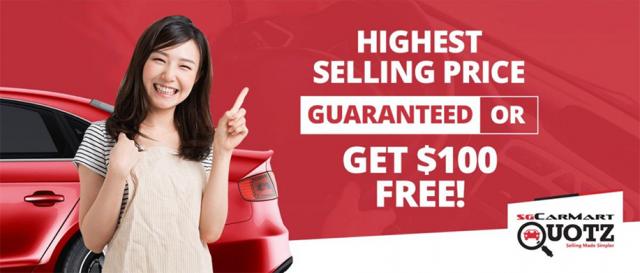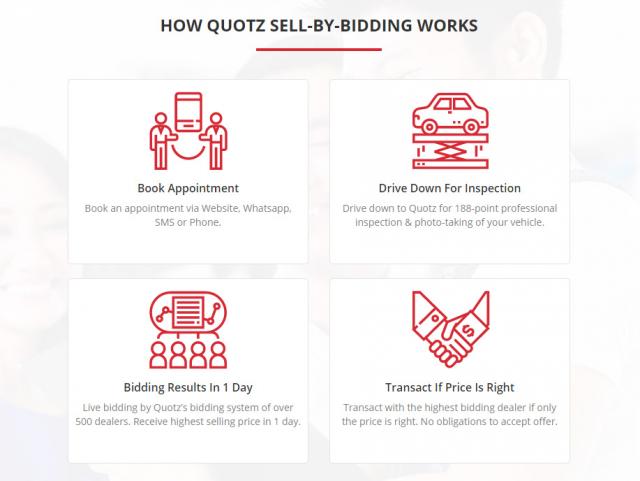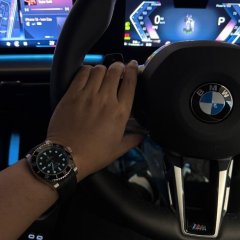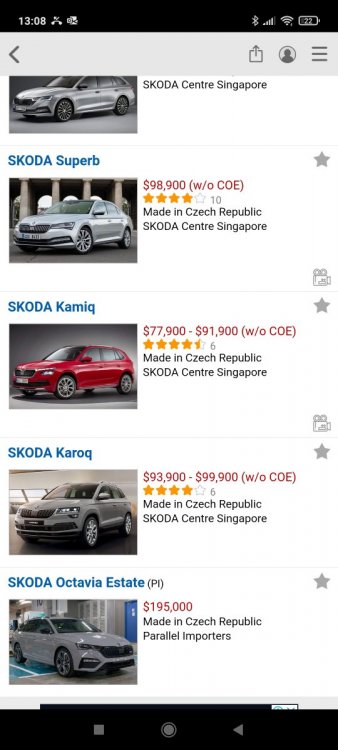Search the Community
Showing results for tags 'PRICE'.
-
Do u all feel that with the shift in our attention towards rising coe prices, we have forgotten how crazy petrol prices have become? Are we getting used to rising petrol prices too?
-
sgCarMart Quotz is Singapore's most reliable online car auction platform. For car owners who want to sell their cars to dealers, we take away the pain of going to multiple shops to ask for quotations. Car owners are able to obtain the highest offers for their cars through the sgCarMart Quotz bidding system which reaches out to over 500 used car dealers. Car owners only have to make a single trip down to the sgCarMart Quotz office. Hand-over date of the vehicle is flexible and on top of that, we offer the highest price guarantee that our final quotation is the highest price in the market. sgCarMart Quotz has been proven to derive higher value for sellers with success rates of more than 80% and multiple testimonies on its facebook page. We are also utilised by government agency such as National Environment Agency (NEA) to conduct vehicle auctions Call 6744 7571 for enquiries or to book an appointment. More info at www.quotz.com.sg
- 2,214 replies
-
- 5
-

-

-
- car sales
- direct owner sale
-
(and 7 more)
Tagged with:
-
Fear mongering? No one force them to bid for the stall at >$3K per month (I think the recent record was $10K for a food stall at hawker centre? siao). Now that budget meal (with minimal liao and small portion) priced at $3.50, still cannot make money? Or was it the high cost of living which make a monthly income of $3K looking pathetic to the stall owners? A hawker food advocate, I find myself turning to fast food more often than before, because a value meal with sides and drink cost <$6, while a plate of chicken rice with a few pieces of paper-thin chicken meat or a plain looking bowl of laksa without egg or hum with coffee cost >$6, the sum just don't add up. Like it or not, high property price (with coffeeshop changing hand at 8 digits figure) does has an impact on commoner like us, and now we are blamed for NOT supporting hawker? Is it reasonable to say that everyday Singaporeans rely on hawker food, hence it ought to be cheap amid high costs of living? Food writer Pamelia Chia weighs in. Source: https://www.channelnewsasia.com/commentary/hawker-food-price-affordable-stall-rental-rising-cost-manpower-4836616 SINGAPORE: In recent years, the financial sustainability of Singapore’s hawker trade has become a pressing concern. Hawkers face numerous challenges, chief among them being rising costs of manpower and raw materials. Some hawkers report operating costs exceeding S$10,000 per month. Yet, the public’s expectation for affordable food options forces them to operate with extremely thin profit margins, sometimes as low as 20 to 30 cents per bowl. The ramifications of this financial strain are profound and manifold. For one, it deters younger generations from entering the trade. Some established hawkers, like Melvin Soh of the 17-year-old hawker business Toast Hut, have closed their businesses due to an inability to meet potential hires’ salary demands. In the case of Toa Payoh zi char stall Hong Sheng Restaurant, which recently ceased operations after 50 years, older hawkers actively discourage their children from taking over. These are not isolated incidents but symptoms of a systemic problem. However, implementing higher pricing is challenging for many hawkers. When hawker Douglas Ng raised his fishball noodle prices by 50 cents, his business dropped by 40 to 50 per cent. How can we understand Singaporeans’ reluctance to pay for hawker food and the complex landscape of hawker food pricing? According to former head chef Nurl Asyraffie Mohamed Shukor, who now runs hawker stall Kerabu by Arang, patrons at hawker centres expect fast, cheap and filling meals. In an 8days interview, he explains: “A lot of people don’t understand my food and they ask, ‘why is it so expensive?’ They don’t understand the work behind it. For the chicken, I need to brine it for two hours, then marinate overnight. The whole process is very tedious but they only see rice, chicken, and salted egg on the plate and think it should be S$3.” However, this seems not to be the case for BlackGoat, a popular hawker stall serving Western-style cuisine, with prices ranging from S$9 for a brownie to S$59.50 for 495g of striploin, significantly higher than traditional local hawker fare. According to BlackGoat’s reviews, customers deem the food “value for money”. It appears that hawker patrons expect local fare to remain cheap, but are willing to spend more money on other cuisines. Is it a case of double standards? While Singaporeans’ reluctance to pay more for hawker food could be attributed to internalised bias - where Singaporean cuisine must justify its worth, while foreign cuisines, such as Italian or Japanese, are priced without question - the issue is more complex. Singaporeans perceive traditional hawker food as “everyday food” rather than an occasional luxury. While fishball noodles may require more work and incur higher production costs than aglio olio, for instance, one could argue that it is the frequent consumption, rather than its lack of inherent value, that drives consumers to demand lower prices. After all, there are successful entrepreneurs who sell local dishes at premium prices outside traditional hawker centres. For example, the air-conditioned restaurant The Coconut Club offers their signature ayam goreng berempah nasi lemak at S$22.80, while a bowl of prawn noodle at Zhup Zhup, an open-air restaurant, ranges from S$14 to S$20. During a recent visit to Zhup Zhup well before dinnertime, I was surprised to see most tables occupied with customers. However, for most hawkers serving traditional fare at hawker centres, the notion that prices should be kept low persists. Hawker centres provide accessible and affordable food options to all Singaporeans, rich and poor. In a 2018 National Environment Agency survey, 83 per cent of respondents said they eat hawker food at least once a week. Hawkers are in an unenviable position as not only the providers of daily sustenance for Singaporeans, but also protectors of a UNESCO-recognised intangible cultural heritage. With chronic diseases such as diabetes and heart disease on the rise, there is an additional responsibility for hawkers to serve healthy options. Is it reasonable to thrust these burdens on hawkers? Should hawker food still be considered everyday food, and hence kept cheap amid the high cost of living in Singapore? In discussions on hawker food pricing, one cannot neglect the elephant in the room: Rent. In response to my commentary on the necessity for hawkers to raise their prices, some netizens suggested that increased hawker prices and consumers’ willingness to pay would only encourage landlords to further increase rental fees, leading to a cycle that does not benefit hawkers. However, contrary to popular assertions of high hawker rents, data from the National Environment Agency (NEA) indicates that the median assessed market rent for non-subsidised market and cooked food stalls has remained at approximately S$320 and S$1,200 per month respectively since 2019, and only about 4 per cent of cooked food stalls in hawker centres are paying rent above the assessed market rate. Proponents of keeping hawker prices low also argue that raised hawker food prices would disproportionately affect lower-income households. However, here’s the irony: The typical earnings of hawkers themselves fall within the second lowest income decile. Having lived in Australia and currently residing in the Netherlands, I’ve observed that it’s common for locals to leave work punctually at 5pm or 6pm, allowing ample time to shop for groceries and cook at home. While affordable food options exist in these countries, they are not comparable to Singapore’s hawker food, which is accessible and fully integrated around workplaces and in housing estates. In countries where eating out is expensive and people are compelled to cook, a shift in working culture is demanded. However, in Singapore, the situation is reversed: Hawker food greatly conveniences and subsidises the lives of Singaporeans. To safeguard our hawker food culture, one of the solutions might be hiding in plain sight. We will need a healthier working culture - one that encourages Singaporeans to cook more at home, like that in other developed countries. While it may seem counter-intuitive, I believe that this cultural change would not only alleviate the pressure on hawkers to provide low-cost meals, but also potentially go a long way in preserving the trade for the future. The debate about hawker food prices elicits complicated emotions in me. As someone who grew up on S$3 chicken rice and 50-cent char siu bao, the abundance of affordable yet superlatively good hawker food has always been a point of pride when speaking about my homeland or hosting international guests. The confluence of good food and low prices in a developed country is so uniquely Singaporean. Yet as the hawker situation grows increasingly dire, I catch myself when I laud this. Because when we talk about the affordability of hawker food as one of its key defining traits, or when we relish being a First World country where superb meals can be had at Third World prices, what are we celebrating?
-
I know we have a separate property thread, but IMO, this deserves a separate discussion. This area will be big, in size and impact.. https://www.tnp.sg/news/singapore/9000-housing-units-including-hdb-be-built-keppel-club-site https://www.channelnewsasia.com/news/singapore/ndr-2019-greater-southern-waterfront-pulau-brani-sentosa-keppel-11819376?cid=h3_referral_inarticlelinks_24082018_cna https://www.channelnewsasia.com/news/singapore/specific-measures-could-dampen-lottery-effect-of-public-housing-11825766 https://www.youtube.com/watch?v=y6xz58yCqGk
- 255 replies
-
- 6
-

-
- greater southern waterfront
- property
- (and 7 more)
-
What I notice when i go Merc/BMW/Audi showrroms is that their price on price list is so high but actually there is huge discounts almost all the time. For merc is often in the form of overtrade. So I thought I would share some discounts that I know. Of coz it is updated all the time so maybe the bros here can share what you have heard so it is easier for ppl to have an idea before heading down to the show room. I shall start first: CLA: 173,888, 8k overtrade and 3k service credit 520i business: 242,800, 10k overtrade E-class and S-class got 10k COE discount or high COE rebate at 76k VW Jetta: 118,800
-
Hi, Just wonder, what do u guys think is the best ways to sell car so that I can fetch the highest price. Will some dealers able to match the price equivalent to selling direct? The problem about selling direct to buyers is the transaction of money, car test drive etc... Unwilling to part with my almost 3 yrs civic but my car is under utilised nowadays.
-
Oh No!!! Our chicken rice price going to go up. Malaysia government to halt export of 3.6 million chickens a month until domestic prices stabilise https://www.channelnewsasia.com/asia/malaysia-halt-export-chicken-36-million-month-ismail-sabri-2701206?cid=internal_sharetool_androidphone_23052022_cna
-
The ice cream saga sibeh power leh... BMW Mini Ice Cream Is Only For Foreigners, Stock Price Plummeted: The Loss Is Equivalent To 460 Million Ice Creams! At the Shanghai Auto Show, netizens broke the news that the staff at the BMW Mini booth refused to distribute ice cream to Chinese visitors, claiming that it was gone, but then not only gave ice cream to foreigners, but two girls also thoughtfully taught foreigners how to eat it. This kind of differential treatment caused dissatisfaction on the Internet. BMW officials later apologized, but did not quell the anger. This incident was not only fermented in China, but was even reported abroad. As a result, BMW shares fell 3%.The market value has evaporated by 2.16 billion euros, or about 16.3 billion yuan,It can be said that a box of ice cream caused a murder, and the loss was great. Many people have no idea about this loss, so it’s easy to understand if you switch to the Luneurs ice cream presented by BMW. The price of this store is not cheap, and a box costs 30 to 40 yuan.Some netizens calculated that the market value lost by BMW is enough to buy 460 million Luneurs ice cream, not to mention giving away a circle at the auto show, it is enough for BMW to invite 1/3 of the people in the country to eat ice cream. The store also issued a statement before, denying that the staff belonged to their family. “The Luneurs brand did not participate in any on-site operations of BMW’s Mini brand activities during the Shanghai Auto Show. We are only a supplier of ice cream products. The two people who appeared in the video The staff and their specific services are not our responsibility and have nothing to do with this brand.”
- 25 replies
-
- 15
-
.png)
-

-
This is a good start The bosses interviewed said the surcharge is similar to previous years and has not been significantly increased due to recent inflation.
- 144 replies
-
- 9
-

-
.png)
-
- cny
- chinese new year
- (and 10 more)
-
Took me quite some time to piece all the information together for this thread, which I have wanted to start a few months back. No right or wrong here, just some personal opinions on why I think the AD plays an important role in determining the resale value of the model sold by them. Feel free to share your thoughts (a forum is meant for members to engage in meaningful discussion, isn't it?) Many ADs has been playing hard to maintain the sales price of new car sold by them, citing reasons such as protecting customer's interest (by not having an unusually wide price fluctuation from month to month), guarantee a good resale value in the used car market (used car price is tagged almost directly to new car pricing), better service if buying the car from them directly, etc. But is that always the case? It is an open secret that when ADs are not able to meet their sales target, they will register the new car and sold it as used car through their used car division of even 3rd parties. I am using PML and Wearnes as an example below, to highlight the adverse effects of doing so. PML (BMW) With the new X3 priced from $302,888 (xDrive20i) / $308,888 (xDrive20i M-Sport) before over trade, the profit margin is between $68K to $71K, which is almost 150% of their respective OMV! Even after an generous O/T of say ~$30K, the net car price will still be around $270K to $280K. Yet PML would rather sell brand new unit at a much lower price (estimated to be ~$250K+) every month to used car dealers, only for it to be listed as used car, than to price it down to similar level for genuine buyers (direct PML customer). This is the screen grab I have taken from sgcarmart.com and the list is not exhaustive. You can even find pre-facelift X3, which was registered exactly a year ago, on the list (there are actually several units available, but the dealer don't want to give potential buyer the impression that they have to lelong the car in their inventory)! Based on the info I have, used car dealers got these units last year at just $200K thereabout, so they can continue to hold and wait (for uninformed buyer). So what does it got to do with resale value? Well, we all know that in a few years time, when the owner want to sell their ride, used car dealers will probably offer PARF + remaining COE value + another few $$$K for the body, and given the record breaking COE premium currently, the owner is likely to burn >$150K in just <5 years (buy at $280K, sell at $105K - $120K max. at 5th year). That's when some will KPKB that BMW has low resale value, nope? Wearnes (Volvo) Let look at the total number of V60 Cross Country and V90 Cross Country registered in the first 5 month of this year, 13 units in total. Want to make a guess how many of this units are sold as brand new used car? 1, 2 or 3? Well, I found 5 units listed on sgcarmart.com (I have reasons to believe there are more units available but not advertised - 'cos I saw at least another 1 - 2 units parked outside Wearnes Pre-Owned, probably management unit, which will eventually be sold as used car). That translate to ~40 to 50% of the new car sold as used. Reason for doing that? Having to meet sales quota without lowering the new car price. BTW, the profits for both model range from ~$67K to >$100K (before O/T), I will leave it to the readers to decide if that is reasonable for the brand. In the case of Volvo, it is a double whammy for the owners (be it brand new from Wearnes or brand new used car / management unit), as not only they are experiencing paper lost as what I have described above, with many used car in the market with transfer count of more than 1, the resale value will be further suppressed. One just need to browse the used car list on sgcarmart.com for the earlier model, and some can be had for ~$14K annual depreciation (in the current climate of $100K COE, so I cannot imagine when the COE return to $50K, these used car will have <$9K depreciation??) One particular unit of V60 Cross Country has been put up for sales for at least 2 months, with asking price of <$190K (for a 6 months old car) till the owner gave up and sell it to Eurokars Pre-Owned, so does that paint a picture that matches what I have written so far?
- 86 replies
-
- 41
-

-
- resale value
- new car
-
(and 7 more)
Tagged with:
-
SINGAPORE - Consumers hoping for used car bargains will likely have to wait longer to see prices easing. While used car prices have been rising along with certificate of entitlement (COE) premiums, industry players say there are early signs of the market weakening after large car COEs breached the $100,000 mark in June. However, dealers are unwilling to drop prices on cars they had bought when the market price was high. Dealers said they have been offering higher prices to buy over used cars as the supply of used cars from new car trade-ins falls. This, in turn, translates into higher resale prices, which benefits sellers. Depreciation value reflects the basic cost of owning a car when comparing its purchase price with what it is worth at the end of its COE lifespan. In June this year, an owner of a 2018 Volkswagen Golf was offered $5,800 more than what the car was worth just three months ago by dealers on Quotz, an online bidding platform. The biggest source of used cars are trade-ins that come with new car purchases. But dealers have been going directly to owners to source for used cars, as new car registrations have fallen significantly during the current period of tight COE supply. In the first six months of 2022, there were 16,567 new car registrations, down 35.7 per cent from the 25,777 registrations seen in the same period in 2021. While fewer new cars were sold, used car transactions have been stable, with 47,480 recorded in the first six months of this year, a 1.4 per cent dip from the 48,173 seen in 2021. Since January, used cars have been selling faster than they did a year ago. At a major used car dealership, it takes less than 30 days for a car to leave its lot. In 2021, the average duration was 60 days. This suggests that more consumers are shifting to the used car market as new cars become increasingly more expensive due to rising COE prices. Dealers seem more hesitant to make higher offers for used cars as COE premiums continue to rise. Dealers are also concerned about whether buyers would be able to accept the higher used car prices. They are also wary of the risk of being caught with overly expensive cars, should COE premiums fall. This is a likely explanation for the stock situation at Sgcarmart, which is the most established player among online used car marketplaces, with more than a thousand dealers. On average, 7,000 to 8,000 used car listings are added to the portal monthly. However, its spokesman said the overall stock of cars has come down slightly since June. That is to say, its dealers are not replenishing their stock of cars as quickly as they are sold. Mr Raymond Tang, honorary secretary of the Singapore Vehicle Traders Association, said dealers may be becoming more selective about the cars they want to sell and how much they are willing to pay for them, following a rush for stock to meet strong demand in the earlier part of the year. https://www.straitstimes.com/singapore/transport/used-car-prices-expected-to-stay-high-for-the-rest-of-2022 Used values of some car models may have also become too inflated to be resold easily, he added. Hence, some dealers are adjusting their valuation when making offers. Demand may also be starting to taper following record-breaking COE premiums. At the latest tender exercise that ended on July 20, the price of an Open category COE was $114,001 while the category for large cars was priced at $110,003. A salesman who has been in the trade for more than 20 years said showrooms for used cars at Automobile Megamart in Ubi have been much quieter in recent weekends. While used car prices rise quickly with new car prices, they tend to lag behind when the opposite happens. Industry watchers say it is unlikely for used car prices to come down in the near future - at least not for a while.
-
A moment of silence for $2 Daiso. According to Singapore Atrium Sale, Daiso Singapore will be adjusting its price from 1st May 2o22 onwards to include GST. This means items will no longer be priced at $2 but at an awkward $2.14. Time to do your shopping at Daiso before the price hike.
- 71 replies
-
- 14
-

-
.png)
-

-

-
https://www.asiaone.com/lifestyle/buying-car-you-need-be-earning-least-8850-first?utm_medium=Social&utm_source=Facebook&fbclid=IwAR1--IIChlz5jayZDU3Ye6xp5AvpjFScyOe0Lzae5eaholn3gXRyGx47etg#Echobox=1648628907
-
Hi bros here. Some noobie question to ask about car price after the 80k coe yesterday Sgcarmart updated skoda price to price without coe. Coincidentally I have noticed some other dealers list car prices without coe as well. May I know how does this work and wads the rationale behind this? High coe so hide the coe? Means buyer bid for own coe? Or dun want list price with coe to frighten off buyers? Not lookin to buy a car at this crazy amount but am puzzled how this works and appreciate if you can help a noob out
-
Hi can anyone help to enlighten me why is the price increment for the SS range so drastic just curious.. was looking at price trends for Tivoli and think its been constant This is the latest price list from sgcarmart there is an almost 80k increase for Tivoli rexton is now at 298k,u can buy the new Defender with this price Pricing scheme or? for discussion,also attached price list 20aug to 9 sep vs 4 sep to 24 sep for reference/comparison https://www.sgcarmart.com/new_cars/newcars_adpage.php?Make=Ssangyong
- 14 replies
-
- 1
-

-
- ssangyong
- price list
-
(and 1 more)
Tagged with:
-
Just heard the news on radio. Esso/Mobil upped the pump price today. Better fill up before the rest follow...
-
Pump prices mostly up 3 cents in Singapore after killing of Iran top general source: https://www.straitstimes.com/singapore/transport/pump-prices-up-3-cents-after-killing-of-iran-top-general?xtor=CS3-18&utm_source=STiPhone&utm_medium=share&utm_term=2020-01-08 8%3A01%3A29 SINGAPORE - Most petrol pump prices here have risen by three cents a litre to yet another record high in the latest fallout from the assassination of Iranian military leader Qassem Soleimani by United States forces last week. A litre of petrol at major fuel retailers here now costs $2.34 for 92-octane grade, $2.38 for 95-octane and $2.77 for 98. Diesel is $1.99 a litre. Caltex's 98 with Techron is $2.80, while Shell's V-Power is $2.94. All prices are before discounts. Caltex raised its prices on Tuesday (Jan 7), while Shell raised its prices on Monday. SPC was the only major player to resist the latest hike, with its prices remaining unchanged as of Tuesday afternoon. Observers said that while the killing of Major-General Soleimani had made the market more volatile, crude prices had already been climbing before his death. Fuelled by a thaw in the US-China trade war and ongoing supply cuts from major oil producers, Brent crude ended 2019 at a four-month high of US$66 a barrel. Brent has since risen further, ending at US$68.91 on Monday. The current volatility is also attributable to uncertainty over how Iran will respond to the killing. Many Iranian leaders have warned of reprisals. But oil industry consultant Ong Eng Tong reckons oil prices will rise, as Iran is likely to retaliate, and that would in turn ignite US sanctions, which will drive oil prices higher. The last time pump prices went up was just before Christmas, when rates moved up by three cents a litre. Compared with 18 months ago, pump prices have climbed seven cents.
-
https://www.sgcarmart.com/new_cars/newcars_overview.php?CarCode=11503 Like take Honda Vezel. Does the $92k include COE? What are the other costs we need to look out for in a new car purchase?
-
i was quoted, 150! is it chop carrot head price?
-
- hyundai
- hyundaipolishing
-
(and 4 more)
Tagged with:
-
Many people say Toyota no longer offers value for money cars in Singapore. Its expensive, not worth it, old fashion specs etc For the money you are paying to buy a Vios with drums brakes, no leather seats, manual aircon, missing DRL, you might as well buy a Korean car. It has better trim level and is much cheaper. In my view the reason why the local agent priced it higher is because the brand is associated with reliability. You may hear people saying Korean cars are just as reliable but the Kia and Hyundai are still one notch below Toyota. Their selling point is they offer better interior design, more features such as wireless HP charging, rear aircon. However not everyone is impressed with these type of stuff. The more stuff the car has, the higher the chances of it breaking down and electronic stuff is usually 1 yr warranty only. What are your views?
- 1,169 replies
-
- 7
-

-

-
- toyota
- vios;toyota;price
- (and 4 more)
-
Price of wedding tables hits new high http://www.straitstimes.com/singapore/price-of-wedding-tables-hits-new-high Wooohooooo! Most Expensive City rocks! I'm really worried for our future generations.
-
lai lai lai... we are 1/3 into the month of May. Oil price has risen to new heights.... so will the greedy petrol cartel raise fuel price in May?
-
http://www.straitstimes.com/singapore/transport/grab-uber-deal-sparks-fears-of-price-hike Grab-Uber deal sparks fears of price hike Consumers and industry watchers are raising concerns that Grab's acquisition of Uber's South-east Asian business will lead to higher fares.PHOTO: ST FILE PublishedMar 26, 2018, 10:38 pm SGT Christopher Tan Senior Transport Correspondent [email protected] Zhaki Abdullah [email protected] SINGAPORE - Consumers and industry watchers are raising concerns that ride-hailing firm Grab's acquisition of rival Uber's South-east Asian business will reduce competition and lead to higher fares. Ms Zhang Bin Bin, who takes both Grab and Uber rides, is unsure how fares will change now that "competition is minimised". "If prices increase or if they match regular taxi prices, I will probably go back to public transport," said the film-maker, 23. Freelance photographer Robin Choo, 27, had the same concerns. "If prices for rides booked through Grab were to rise, I think I will have reconsider my travel options," he said. Drivers interviewed raised concerns about their incentives and commission rates. Private-hire drivers pay about 20 per cent of each fare to their operators. Mr Ken Tan, 45, is concerned about how the move might affect his earnings. While he has driven for both Uber and Grab, he said he was able to earn more driving for Uber due to the better driver incentives. Drivers now no longer have the option of choosing another operator if they are dissatisfied with their current firm, he said. Mr Thanaraj Suppiah, 36, who has been driving full-time for Uber since last June, said: "I will have to see how well Grab takes care of drivers." Mr Ang Hin Kee, executive adviser to the National Taxi Association as well as the National Private Hire Vehicles Association, said consumers and drivers need more choices, not fewer. Nonetheless, if the merger is approved here, he hopes that end users will be better off. "With potentially lower cost of operations via lower staff overheads and less spending on advertisement, the new entity can focus on delivering better terms for drivers and commuters," he said. "But if it infringes on commuter and driver interests, I hope the regulators can steer it back on track." Singapore University of Social Sciences senior lecturer and transport economist Walter Theseira said regulators can do one of two things to ensure that the market remains equitable for all parties. One is to have a dominant player which is well regulated. The other is to have multiple players and let natural competition keep them in check. "My personal view is that there has to be first of all, evidence that market size leads to efficiency," he said. "Secondly, there must be an appropriate lever to ensure that an enlarged player does not abuse its power." Meanwhile, consumers do not seem too worried that Grab - with its ambitions of becoming a major player in the food, payment and loan sectors - would have access to information on how they travel, eat and spend. "With the Government's cashless drive, consumers like myself will have to face the fact that my data is being collected," Mr Choo said. "My concern lies with how secure my data is." Said Ms Zhang: "I am quite indifferent to that... since many apps or even devices are already collecting such data." Grab Singapore head Lim Kell Jay said: "We have always cared about our customers' well-being and as a start, we will immediately extend our free personal accident insurance policy to all new interested Uber drivers and riders who choose to be part of our platform. "We expect our combined operations to create a better experience for our community of drivers and passengers... we expect to see shorter wait times and faster pick-ups. This would mean better productivity for our drivers, and better reliability for our passengers."
























